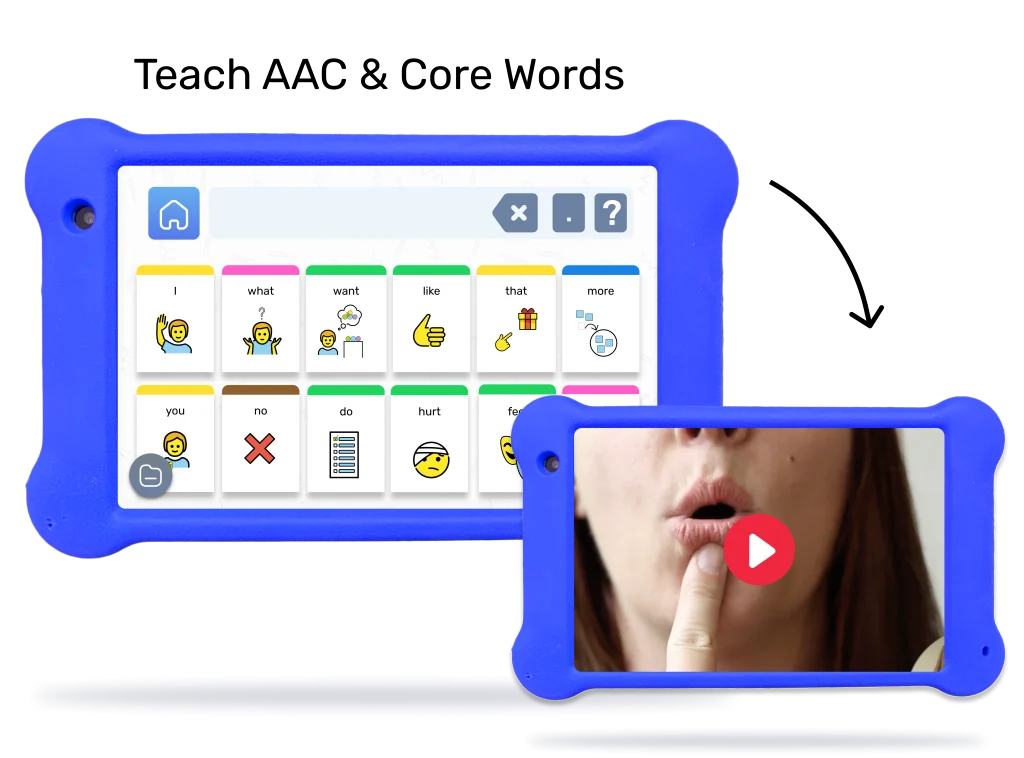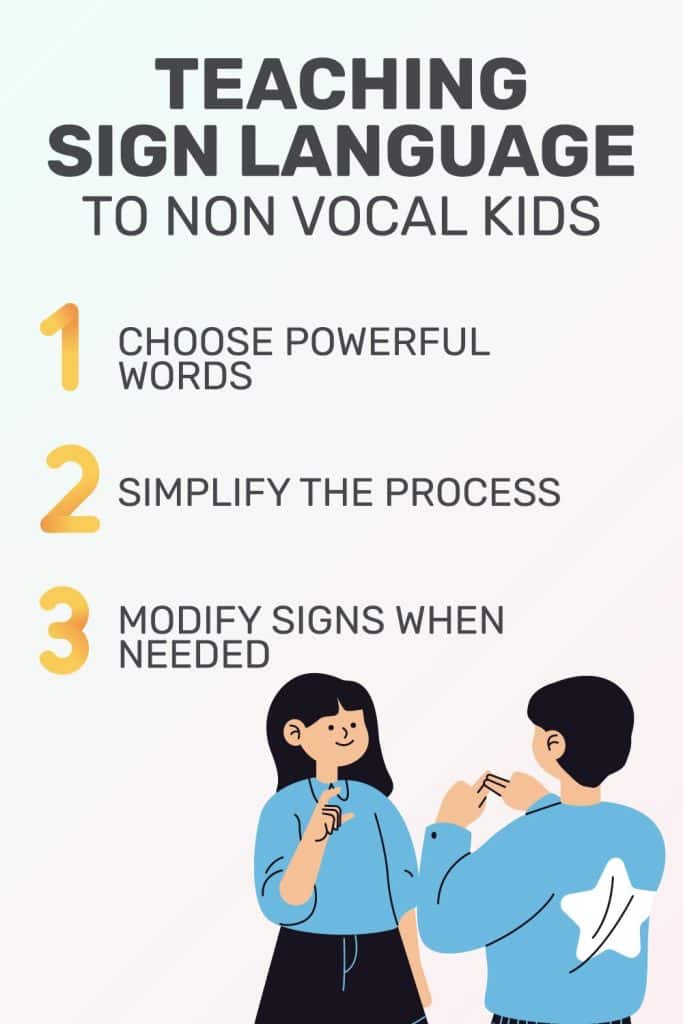As a parent, the quest to connect deeper with your child is a journey of love and learning. This journey takes a unique turn when figuring out how to teach sign language to an autistic child. It’s a process that opens up new avenues of understanding and interaction. In this guide, we’ll navigate this path together, offering practical tips and insights to make this journey smoother and more rewarding.
Table of Contents
1. Choose Powerful Words
Let’s be real-you can’t learn how to speak sign language overnight! And lucky for you, you don’t have to know fluent sign language to use signs as a communication stepping stone for your child. The first step to teaching your child signs is to pick the most powerful words to start with. Work with those closest to your child to uncover what seems to motivate your child the most. What parts of their day does your child look most forward to? What activities are the most fun? Make a list of the words that you think your child would say if they could say them during these activities.
You might notice that most of the words on your list are the names of things, like toys, foods, and favorite videos. Although teaching your child the signs for their favorite foods is certainly an important aspect of helping them communicate successfully, it may feel impossible to teach them every food-related sign that is relevant to their preferences.

Goally | Apps that Teach Kids AAC & Core Words
Is your child facing challenges in expressing themselves or communicating effectively? Goally has one of the best language language learning apps for kids to support their journey in building essential communication skills!

The Word Lab and AAC Talker apps provide a simple, engaging platform for your child to learn core words and become a functional communicator right from the start. Customize the experience with a voice that suits them, and watch as their confidence grows in expressing their thoughts and needs!
2. Simplify the Process
To simplify things as you take your first steps to teaching sign language to your non verbal child with autism, focus on teaching words that help you hone in on the main intention of your child’s communication. For example, teach your child to sign the word eat so that they can indicate that they are hungry. The eat sign is simply touching the closed fingers of one hand to your mouth. Once you know your child wants to eat, you can then use the food items in the kitchen to offer them choices of what they want to eat.
This helps keep your word list manageable you begin your learning. Choose simple words to cover most daily routines bases. Those can include: drink, go, play, more, done, different, help, want, open, and no. There are several free, online resources to show you how to sign these and other powerful words, including Spread the Sign. Spread the Sign is a searchable collection of videos that show the full movements to sign each word.

Read More: 2-Year-Old Not Talking | When Is It Normal?
3. Modify Signs When Needed
Some children may have difficulty moving their hands and fingers to match sign shapes exactly. This might be due to young age or physical differences, both of which impact a child’s ability to move their hands as an adult might. If your child has difficulty moving their hands precisely, think about how you could modify a complex sign to an easier form.
For example, if your child is not able to close their fingers and touch their mouth for the eat sign, you might teach them an adapted version of this sign, such as putting a fist or open palm to their mouth instead. You can even make up a sign for a word and then teach your child and those closest to them what that sign means. Remember that the focus of teaching your non vocal child with autism how to use signs is not to teach them to be a fluent sign language user, but rather to give them powerful stepping stones to meet immediate communication needs early on in their language learning journey.
4. Follow Your Non Vocal Child’s Motivation to Sign
Your child will be most motivated to learn the words that match their wants and ideas. You’ll need to model signs to teach sign language to your non vocal child with autism. You might be wondering when you should model signs, and how often? Watch and listen to your child during motivating routines and play activities so that you know what they are most interested in from moment to moment. Look for the ways that your child already communicates with you during these activities.

Read More: The Best Toys for Nonverbal Autism by Age Group
For example, maybe your child always walks in and out of the kitchen right around lunch time each day. Or perhaps your child takes your hand and pulls you to the door when it is time to go for your daily walk together. Saying the words and showing the signs that go along with your child’s intentions in these moments will have the biggest impact on building your child’s inventory of signs. Watch and listen carefully to find new ways in which your child may be communicating their wants and ideas in different situations so that you can increase your opportunities to model words and signs more and more over time.
5. Frequently Speak & Sign to Your Non Vocal Child with Autism
Teaching sign language to a non vocal child with autism requires repetition. Children learn new skills by watching others, and having a chance to practice what they see during fun and motivating activities. If you want to teach your child how to use signs to communicate, you need to communicate using signs yourself. As you care for, teach, and play with your child, find ways to model the powerful signs you selected. As you talk to your child during routines and activities that they enjoy, sign those keywords simultaneously.
You don’t need to use a sign for every word in your spoken language, of course- that would be overwhelming for both of you! Instead, have your powerful keywords in mind and find ways to work them into what you’re doing together, signing as you say them. Make the movements of the sign in time with your spoken words, and make sure that you are in a position that makes it easiest for your child to see you, and hear you. As you get more comfortable signing, you may be able to sign two, even three words in your sentences as you speak. Speak and sign at a pace that helps your child follow along. Be fun and animated as you model with speech and signs to encourage your child to watch what you are showing them.
Goally | The Safest Tablet for Kids

7. Inspire Sign, Don’t Require it
Although modeling signs is the most important thing to remember as you start to teach your child how to use sign language, practice is an essential part of learning any new skill. You may be tempted to require your child to use their new signs. Parents tend to do this by withholding what they want until they fulfill a command. Or even using your hands to put their hands into the shape of the sign. However, these intrusive strategies put too much focus on demonstrating this new skill before your child is ready. It may result in barriers that discourage your child from wanting to learn with you. If you have been modeling a new sign for a while and you think your child is ready to try practicing the sign, try gentle prompts to encourage practice.
8. Use Language Prompts for Your Child with Autism
One effective way to prompt language development in nonverbal children is by modeling the sign and waiting expectantly for them to imitate. By demonstrating the sign and maintaining eye contact while waiting, you communicate your anticipation for their response. For instance, if your child pulls you towards the door for a walk, you can pause, model the sign for “go,” and silently wait, giving them a chance to mimic the sign. Another helpful prompt is using a carrier phrase and allowing your child to complete it with their new sign. If they don’t imitate the sign when you’re ready to go for a walk, you can model the phrase “Let’s go” while signing “go” and prompt them to finish the sentence. Encouragement is crucial during these moments to keep them motivated and prevent them from avoiding challenges that may feel overwhelming.

Goally | Teach Kids AAC & Core Words
Is your child facing challenges in expressing themselves or communicating effectively? Goally’s language apps support their journey in building essential communication skills! All of these apps are included our skill-building tablet made for kids.

The Word Lab and AAC Talker apps provide a simple, engaging platform for your child to learn core words and become a functional communicator right from the start. Customize the experience with a voice that suits them, and watch as their confidence grows in expressing their thoughts and needs!
But we don’t stop there. Our Balloon App helps build the skills needed to use AAC by engaging your child with fun, interactive “pop the balloons” exercises. It’s a game-changer for kids who need that extra boost in communication.
Final Thoughts: Teaching a Non Verbal Child Sign Language
Remember that learning new words and signs takes time and each child will be on their own schedule. The important thing is not how quickly they learn the sign, but how invested they remain in the process, so keep things positive and add gentle challenges along the way.
FAQ’s About How to Teach Sign Language to Autistic Child
What is the best way to start teaching sign language to an autistic child? Start with simple, useful signs like "more", "eat", "drink", and "play". Use these signs consistently in relevant situations. How can visual aids help in teaching sign language? Visual aids like flashcards can reinforce learning by providing a visual reference for each sign. Can sign language help with emotional regulation in autistic children? Yes, sign language can help children express their feelings and needs, reducing frustration and improving emotional regulation. How long does it typically take for an autistic child to learn sign language? The learning pace varies for each child. Consistent practice daily can yield noticeable progress over weeks or months. Are there specific sign language programs designed for autistic children? Yes, programs like Makaton and Visual Communication Systems are designed specifically for individuals with communication difficulties.
This post was originally published on 10/14/2022. It was updated on 02/22/2024.

Goally
We help parents teach their kids life skills, like doing bedtime and morning independently. Backed by science, we incorporate evidence-based practices and expert-informed designs in all of our apps and content.






